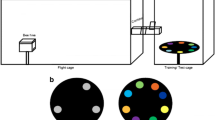Abstract
In field experiments, honeybees learned to discriminate between rewarded and unrewarded feeders differing in color. After learning, familiar feeders were presented against a different background or the place of presentation was shifted several meters away. Both innovations decreased the average percentage of correct choices. This decrease is considered to be evidence of “contextual isolation.” This isolation was partial because the discrimination of learned colors was partially retained under the new conditions. This appears to be the first known example of partial contextual isolation. Significant individual differences were revealed. Some bees demonstrated spontaneous color preferences while the others did not. Four out of 34 bees failed to learn the rewarded color even after 30–40 visits.
Similar content being viewed by others
References
Baerends, G.P., “Fortpflanzungverhalten und Orientierung der Grabwespe Ammophila campestris Jur.,” Tijdschrift voor Entomologie 84, 68–275 (1941).
Beiko, V.B., Kartsev, V.M., and Mazokhin-Porshnyakov, G.A., “Comparison of Food and Nest Orientation in Paper Wasps (Hymenoptera, Vespidae),” Zoologicheskii Zhurnal 60 (7), 1109–1112 (1981).
Bitterman, M.E., “Vertebrate–Invertebrate Comparison,” in NATO ASI Series, Vol. 17: Intelligence and Evolutionary Biology, Ed. by H.J. Jerison and I. Jerison (Springer-Verlag, Berlin, 1988), pp. 251–276.
Colborn, M., Ahmad-Annuar, A., Fauria, K., and Collett, T.S., “Contextual Modulation of Visuomotor Associations in Bumblebees (Bombus terrestris),” Proceedings of the Royal Society of London 266, 2413–2418 (1999).
Collet, T.S. and Kelber, A., “The Retrieval of Visuo-Spatial Memories by Honeybees,” Journal of Comparative Physiology A163, 145–150 (1988).
Fauria, K., Dale, K., Colborn, M., and Collett, T.S., “Learning Speed and Contextual Isolation in Bumblebees,” Journal of Experimental Biology 205, 1009–1018 (2002).
Frisch, K. von, “Der Farbensinn und Formensinn der Bienen,” Zoologische Jahrbücher (Physiologie) 35, 1–188 (1914).
Hasratyan, E.A., Selected Works. The Reflexological Theory of Higher Nervous Activity (Nauka, Moscow, 1983) [in Russian].
Kartsev, V.M., “Local Orientation and Learning in Insects,” in Russian Contributions to Invertebrate Behavior (Praeger Publishers, Westport, 1996), pp. 177–212.
Kartsev, V.M., “Situational Choices among Alternative Visual Stimuli in Honeybees and Paper Wasps when Foraging,” in Honeybees: Foraging Behavior, Reproductive Biology and Diseases (Nova Science Publishers, New York, 2014), pp. 93–118.
Kartsev, V.M. and Mazokhin-Porshnyakov, G.A., “The Scheme of Behavioral Decision Making during Search Tasks in Insects,” Doklady Akademii Nauk SSSR 264, 756–759 (1982).
Kartsev, V.M., Semenova, S.A., and Mazokhin-Porshnyakov, G.A., “Independent Acquisition of Individual Habits in Insects under Different Behavior Motivations,” Zoologicheskii Zhurnal 66 (6), 860–867 (1987).
Kartsev, V., Oganesov, T., and Kalinin, D., “Learning at Consequential Stages of Orientation in Bumblebees and Paper Wasps,” in Proceedings of the 3rd European Congress on Social Insects (2005), pp. 22–27.
Kartsev, V.M., Ryzhkova, O.V., and Terehov, Ya.A., “Abilities of Honey Bees Apis mellifera Linnaeus, 1758 and Paper Wasps Vespula spp. (Hymenoptera: Apidae, Vespidae) to Situational Learning,” Caucasian Entomological Bulletin 11 (1), 91–97 (2015).
Lopatina, N.G., Signal Activity in a Honeybee Colony (Nauka, Leningrad, 1971) [in Russian].
Mazokhin-Porshnyakov, G.A., The Vision of Insects (Nauka, Moscow, 1965) [in Russian].
Mazokhin-Porshnyakov, G.A., “Insects’ Abilities in Learning and Generalizing Visual Stimuli,” Entomologicheskoe Obozrenie 47 (2), 362–379 (1968).
Mazokhin-Porshnyakov, G.A., “On Convergent Similarity between the Behavior of Insects and Vertebrates,” in Problems of General Entomology (Proceedings of the All-Union Entomological Society, Vol. 63) (Nauka, Leningrad, 1981), pp. 154–157 [in Russian].
Mazokhin-Porshnyakov, G.A. and Vishnevskaya, T.M., “Demonstration of the Ability of Bees to Differentiate between Circles, Triangles, and Other Simple Shapes,” Zoologicheskii Zhurnal 44 (2), 192–197 (1965).
Mazokhin-Porshnyakov, G.A., Taimova, G.A., Frolova, A.I., and Shamuhamedova, L.Sh., “The Effect of Previous Training on the Behavior of Bees in New Surroundings,” Zoologicheskii Zhurnal 50 (3), 383–392 (1971).
Menzel, R., “The Honeybee as a Model for Understanding the Basis of Cognition,” Nature Reviews. Neuroscience 13, 758–768 (2012).
Oganesov, T.G., “Individual Variation in Spontaneous Color Preferences of Foraging Bumblebees Bombus derchamellus Kby. and Bombus lucorum L. (Hymenoptera, Apidae),” Vestnik Moskovskogo Universiteta. Seriya 16. Biologiya, No. 4, 33–36 (2005).
Plokhinsky, N.A., Biometry (Moscow State University, Moscow, 1970) [in Russian].
Reznikova, Zh., Animal Intelligence. From Individual to Social Cognition (Cambridge University Press, Cambridge, 2007).
Rokitsky, P.F., Biological Statistics (Vysshaya Shkola, Moscow, 1973) [in Russian].
Srinivasan, M.V., “Honey Bees as a Model for Vision, Perception, and Cognition,” Annual Review of Entomology 55, 267–284 (2010).
Worden, B.D., Skemp, A.K., and Papaj, D.R., “Learning in Two Contexts: the Effects of Interference and Body Size in Bumblebees,” Journal of Experimental Biology 208, 2045–2053 (2005).
Zhang, S., Bock, F., Si, A., Tautz, J., and Srinivasan, M.V., “Visual Working Memory in Decision Making by Honeybees,” Proceedings of the National Academy of Sciences 102 (14), 5250–5255 (2005).
Author information
Authors and Affiliations
Corresponding author
Additional information
Original Russian Text © V.M. Kartsev, Ya.A. Terehov, 2017, published in Zoologicheskii Zhurnal, 2017, Vol. 96, No. 8, pp. 926–936.
Rights and permissions
About this article
Cite this article
Kartsev, V.M., Terehov, Y.A. Discrimination between learned colors against a new background and in a new place in honeybees, Apis mellifera (Hymenoptera, Apidae). Entmol. Rev. 97, 853–862 (2017). https://doi.org/10.1134/S0013873817070028
Received:
Published:
Issue Date:
DOI: https://doi.org/10.1134/S0013873817070028




